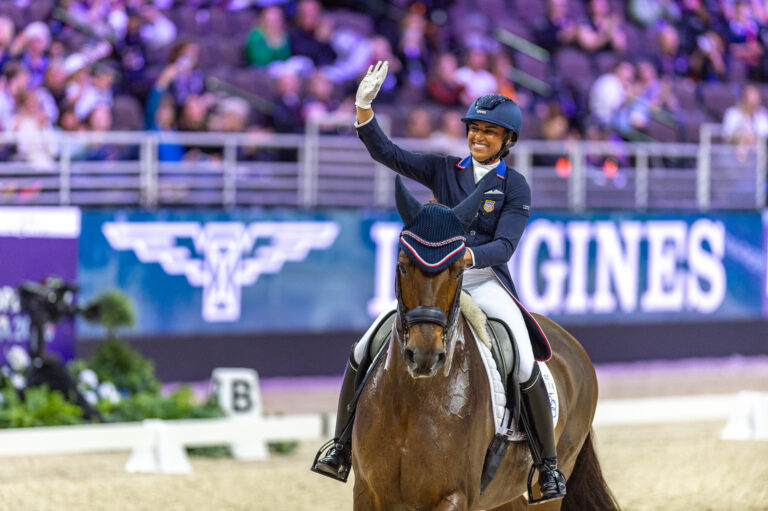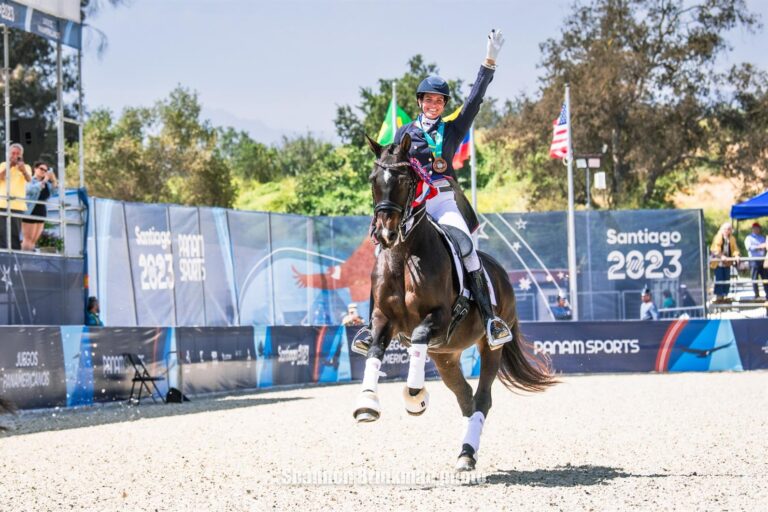Joe Dotoli knows horses, and he knows the importance of good head protection when riding. That is why the Rhode Island horseman campaigned for years to make ASTM International/Safety Equipment Institute-certified helmets mandatory in U.S. Equestrian Federation-recognized hunter/jumper competition. As he noted, “It’s a dangerous sport, so let’s protect ourselves as best we can and get on with what we love.”

© Amy K. Dragoo
Even after the adoption of the USEF helmet rule—which started for Junior hunter/jumper/equitation riders in the late 1980s—riders continued to approach Dotoli about which helmets were the best. All the veteran horseman could tell them was which models met the minimum ASTM/SEI standard on a pass/fail basis. There was no way to compare the relative safety of certified models or to determine which ones offer the best protection against not only severe injury, but concussion. Considering how helmet technology has been progressing in other sports, Dotoli thought this wasn’t enough.
One day, a friend sent him an article about the Virginia Tech Helmet Lab’s work to test and improve helmet safety in sports like varsity football, soccer, cycling and hockey. The possibility of equestrian helmet testing was mentioned, and that was all Dotoli—who was on the safety committees of both the USEF and the U.S. Hunter Jumper Association at the time—needed to know.
Dotoli contacted Stefan Duma, PhD, the lab’s founder and Virginia Tech professor of engineering in the Department of Biomedical Engineering and Mechanics. An expert on impact injury biomechanics, Duma confirmed his team’s interest in launching an equestrian helmet study at its Blacksburg, Virginia, facility. The result, three years later, is a new, unbiased helmet ratings system scheduled to be unveiled this fall. This research-based system is expected to help English and recreational riders make more informed helmet purchases, as well as drive improvement in helmet safety as manufacturers seek top ratings for their products.
The Next Step
The helmet lab’s STAR (Summation of Tests for the Analysis of Risk) ratings system uses a scale of one to five stars, with a five-star helmet deemed the safest. This system is intended to supplement, rather than replace, existing ASTM/SEI certification of equestrian helmets.
The ratings will be based on lab tests utilizing special equipment to assess a helmet’s ability to protect the head against not only severe injury but “smaller”-impact injuries, such as concussion. “The ASTM standard was a place to start,” Dotoli explained. “But the next step is what we are doing now.”

© Amy K. Dragoo
The emphasis on concussion protection is important because contrary to what some riders might believe, that seemingly harmless “bell-ringer” can be dangerous, too. Though little discipline-specific data on equestrian head injuries is widely available, awareness has been growing about the long-term effects of concussions and repetitive head trauma. Repeated concussions are now believed to cause cumulative brain damage, and athletes with a history of concussions tend to be more prone to future brain injuries.
“‘Traumatic brain injury’ or ‘TBI’ is an umbrella term that describes a wide variety of diagnoses,” explained neurosurgeon Lola Chambless, who is also an equestrian and a helmet safety advocate. “Broadly, the brain can be injured whenever it is subject to excessive forces; in equestrian injuries this is usually a rapid deceleration from a fall. These forces can cause shearing [tearing] of the neural tracks in the brain tissue itself or can cause tears of the brain’s blood vessels leading to hemorrhage in or around the brain.”
Chambless is among those concerned that current equestrian helmet design offers inadequate protection against concussion, the more “silent” type of TBI. “Current helmet technology is designed to prevent the severe brain injuries that result from these torn blood vessels or fractures to the skull,” she said. “We know that helmets have saved many equestrian lives and lessened the severity of many more TBIs. However, there is less evidence about the degree to which they protect riders from more mild injuries, like concussions.”
The Rotational Factor
To protect the brain and skull, a helmet should ideally slow down any motion during impact. Where the helmet lab looks to make a difference in helmet testing is in its measurement of rotational acceleration rates. This is in addition to the linear acceleration measurement that is dictated by the ASTM/SEI standard.
As Barry Miller, PhD and the lab’s director of outreach and business development, explained, the standard ASTM/SEI tests involve dropping helmeted headforms in fixed positions onto both a flat steel anvil and an anvil with a sharp edge. These tests are set up to measure a helmet’s response to linear acceleration.
However, as Miller noted, linear movement is only one part of the concussion equation because hitting a surface at an angle, which happens a lot in equestrian falls, triggers rotational movements of the head that are out of sync with the movement of the neck, torso and/or lower limbs of the body. “Most head impacts are not through the center of mass (centric) and thus do not result in a pure linear response; the head rotates about the various axes,” he said. “During these rapid head movements, the stress, strain and pressure on the brain as it tries to maintain its position in the skull can cause these brain injuries.”
For these reasons, team members have developed a new testing protocol. It uses
- a sensor package that can measure rotational velocities,
- a testing rig that can mimic equestrian fall trajectories, and
- headforms with chins and flexible “necks.”
This testing enables them to capture rotational kinematics in addition to linear kinematics. (Kinematics is a branch of dynamics that deals with aspects of motion apart from considerations of mass and force.) Most importantly, the testing also allows them to assess a helmet’s ability to reduce these forces/slow them down. It is hoped that this additional testing will help manufacturers address a perceived gap in concussion protection.
Initial Tests and Takeaways
To help establish the parameters for the preliminary field tests that would jump-start their new ratings system, helmet lab team members conducted a literature analysis and data review using recent injury reports from the USEF. Key also to the research were 100 videos of riding falls from recent major equestrian events, including the Olympic Games, which were analyzed
by Duma.
The video analysis yielded information about the most common location of impact (with the back of the head most often impacted, at a rate of 31 percent); the degree of impact energy with which the head usually hit the ground (medium impact energy was observed in most cases); and the relative hardness of the typical riding surfaces in play (ranging from the softest, sand, to the hardest, dirt).

© Amy K. Dragoo
As Duma noted in a presentation to the USHJA, falls from horseback are short events—in the 5-10 millisecond range—requiring testing equipment that can sample quickly. In addition, the height of the fall dictates the impact energy, so the “secret sauce,” he said, would be to design a helmet that protects the head in falls with different impact energies.
The focus in this project’s final phase has been on duplicating the preliminary field tests in the Virginia Tech lab using one specific test rig, a specially selected “impactor face” and a fine-tuned protocol. The inaugural batch of test helmets will likely include between 30 and 50 models, Miller said.
As he went on to confirm, manufacturers did not “opt in” for this testing. This means that the lab can test any commercially available model designed for use in pleasure riding, hunter/jumper, dressage or eventing that has been ASTM/SEI certified. However, “We did ask many of the company reps and other industry retailers to provide us with a list of the more popular models, etc., to ensure we have a robust sampling,” Miller said. Helmets will be evaluated as entire functional systems, including any standard features with which they are equipped (including any inserts, visors, optional padding, etc).
Once the testing is complete, the team will post its initial helmet ratings—at a date to be announced—on vt.edu/helmet. Once the ratings are posted on the website, there will be multiple ways for consumers to sort and filter their searches, Miller said.
UPDATE: The Virginia Tech Helmet Lab has released its STAR Equestrian Helmet Ratings, which can be found here.
Going forward, the helmet lab team plans to continue with its equestrian helmet ratings program. The team is also open to working with helmet manufacturers in the development phase of new prototypes.
There are no immediate plans to study youth riding helmets, a project that the team confirmed would require different testing parameters and additional funding. However, Dotoli said he is interested in exploring the safety of equestrian “air vests” (body protectors) with help from the helmet lab.
Meanwhile, Dr. Chambless offered equestrians this advice: “All riders should wear a helmet every time, every ride. We know this may save us from a devastating neurologic injury or death. However, we also must advocate for our helmet manufacturers to continue to work toward concussion prevention and provide scientific evidence to help inform our choices for safety equipment.”
Star Quality

© Amy K. Dragoo
Although advances in helmet technology are obviously intended to mitigate the severity of head injuries, remembering that no helmet is truly concussion-proof is important. As the Virginia Tech Helmet Lab’s website states: “Any athlete can sustain a head injury, even with the very best head protection. The helmet ratings identify the helmets that best reduce your chances of sustaining a concussion.
“‘STAR’ stands for the Summation of Tests for the Analysis of Risk, and the STAR score is calculated based on a helmet’s performance in a series of impact tests,” the website continued. “The impact conditions are sports-specific and inclusive of the broad range of head impacts that athletes are likely to experience. STAR is based on two fundamental concepts:
- tests are weighted based on how often people experience similar impacts; and
- helmets that lower linear and rotational head acceleration reduce injury risk.”
Hunter Hair
A question frequently fielded by the team at the Virginia Tech Helmet Lab pertains to the role of hair in helmet retention or fit.
It has been common over the years for hunter/jumper riders with long hair to buy a slightly larger helmet so they can tuck their hair up neatly inside it. This can, in some cases, result in a helmet that rocks back and forth during riding rather than remaining securely positioned on the head.
Is this dangerous? Possibly. However, Barry Miller, the lab’s director of outreach and business development, says the key factors to consider are:
- whether the helmet retention system (harness, closure mechanisms, etc.) keeps the helmet in place during the initial impact; and
- whether the helmet is designed to decrease both linear and rotational acceleration rates to minimize the likelihood of concussion.
In the meantime, lab team members said that if hair plays any role in helmet safety, it might actually be slightly helpful in rotational scenarios. This is because it provides a natural “slip plane” that moves independently of the helmet, possibly helping to deflect or reduce potentially damaging rotational forces on the skull and brain during impact.
Seed funding for the Virginia Tech Helmet Lab’s equestrian helmet initiative came from the U.S. Hunter Jumper Association, followed by donations from the New England Equitation Championships, the U.S. Equestrian Federation and the U.S. Eventing Association. These were matched by a donation from Jacqueline Mars and an anonymous gift boosting the total raised to the required $450,000.
This article originally appeared in the Fall 2022 issue of Practical Horseman.











